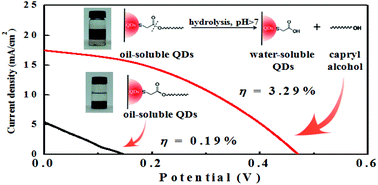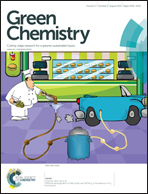Application of quaternary Cu2ZnSnS4 quantum dot-sensitized solar cells based on the hydrolysis approach†
Abstract
The band-tunable quaternary alloys have more excellent photoelectric properties and stability than their binary or ternary components, but their application as sensitizers in quantum dot-sensitized solar cells (QDSSCs) has seldom been reported. The key feature of this problem is that the fairly small-sized quaternary quantum dots (QDs) require the use of 1-dodecanethiol (DDT) to suppress the growth of QDs, which cannot be displaced by a bifunctional molecular linker. Herein, we developed a novel synthesis and functionalization strategy for presynthesized Cu2ZnSnS4 (CZTS) QDs by utilizing mercapto-acetic acid octyl ester as the capping ligand. Unlike the commonly used ligand exchange approach, the long alkyl chains are removed via a hydrolysis procedure at pH > 7. Benefitting from the broad absorption spectral range, good loading ability and the improvement of the electron transport process after ligand hydrolysis, the constructed “green” CZTS QDSSCs finally achieved an impressive conversion efficiency of 3.29% with a high short-circuit current of 17.48 mA cm−2 without further modification. This efficiency is the first reported value for CZTS QDSSCs so far, which is comparable to most efficiencies for single species sensitizers of around 3%, and demonstrates that it is possible to obtain comparable or even better photovoltaic performance than the toxic cadmium or rare indium QDs.



 Please wait while we load your content...
Please wait while we load your content...